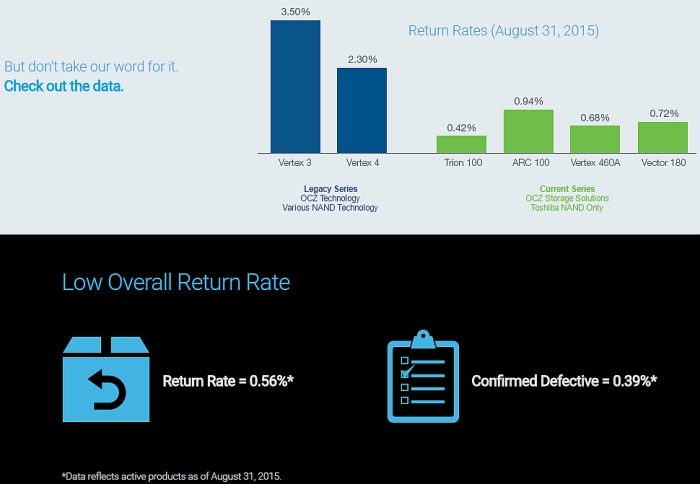Index
- OCZ Trion 150 480GB SSD Reviewed
- Performance Specifications
- Packaging
- Testing Methodology
- Benchmark Results - CrystalDiskMark x64 v5.1.2
- Benchmark Results - ATTO Disk Benchmark v3.05
- Benchmark Results – Iometer v1.1.0
- Benchmark Results – AS SSD Benchmark v.1.8.5636.37293
- Benchmark Results – PlayStation 4 SSD vs HDD
- Price-per-Gigabyte Comparison (March 28, 2016)
- Conclusion
- All Pages
Conclusion – Fantastic sustained sequential performance, but 4K random IOPS could be higher
While the drive doesn’t look any different than its predecessor on paper except for newer 15-nanometer Toshiba TLC NAND flash, the OCZ Trion 150 has a hidden secret ingredient that the paper specifications will not show. We are talking about the drive’s surprising sustained read and write performance at both small and large file sizes. Based on our ATTO benchmark results, the Trion 150 480GB managed to maintain 554 to 562MB/s read speeds between 64KB and 64MB transfer sizes, and 518 to 533MB/s write speeds between 64KB and 64MB transfer sizes, making this drive one of the more efficient in the “sustainable sequential performance” category for both small and large raw data sets.
In the past, OCZ drives have been known for rather high failure rates, and this is even highlighted in a dedicated section on the company’s Wikipedia entry. However, since the acquisition by Toshiba in January 2014 and subsequent migration of product manufacturing into Toshiba’s own hands, average drive failure rate has dipped surprisingly below 1 percent. The drive’s Toshiba TC58 controller is the same one used in its Trion 100 predecessor, and according to OCZ reliability data released in August 2015, the overall return rate of the company’s storage solutions was only at 0.57 percent that year.
Last year, only 0.42 percent of Toshiba-based Trion 100 series drives were returned. Additionally, the company notes that only 0.31 of total manufactured drives are faulty, which is an excellent case in point that the transition to in-house technology has been a major factor in reducing product return rates and greatly improves the customer purchasing experience.
The OCZ Trion 150 480GB is available for $117.49, making it one of the most affordable 480GB drives on the market with 550MB/s sequential read performance that closely approaches the 600MB/s limit of the SATA III specification. In our tests, however, we found this drive topping out at 563MB/s read speeds and 536MB/s write speeds, both exceeding OCZ’s rated performance specs and highlighting its ability to easily outpace other TLC-based drives like the Crucial BX200 480GB.
If one is simply looking at this drive for the appeal of newer Toshiba 15-nanometer TLC NAND flash, however, prepare to be slightly disappointed. For just $5.40 more, the SanDisk Ultra II 480GB featuring SanDisk’s Advanced 19-nanometer TLC NAND still offers 8.16 percent more 4K random read performance (98,000 versus 90,000 IOPS) and 35 percent more 4K random write performance (83,000 versus 54,000 IOPS). In terms of IOPS, the drive still doesn’t come up to the top-tier TLC performance bracket where the Samsung 850 EVO 500GB (Samsung 128Gbit 40nm TLC V-NAND) is placed, but it does take a good shot at sustained sequential read and write performance, and in some cases, outperforms Samsung’s 3D-stacked TLC NAND offering.
Competitive Warranty
OCZ’s ShieldPlus warranty program is also an advantage to the Trion 150 series worth mentioning. In the past, customers have experienced unnecessary frustration over RMA handling times by customer service representatives from many well-known SSD manufacturers. It would traditionally take more than a week to return a defective unit and receive a replacement, during which time a user’s system would be out of commission or running with a less-than-ideal spare drive. With OCZ’s warranty program, a customer can simply provide their serial number to an OCZ customer service agent and if the drive is determined defective, a new replacement will be sent out immediately at no additional cost. This program is currently offered in North America and EMEA, and additional regions will be available in the future.
Final Word
At the end of the day, the OCZ Trion 150 480GB performs as expected for a drive with triple-level cell (TLC) and is at the top of the ranks for sustained sequential performance below $120. However, for just $5.40 more, the SanDisk Ultra II 480GB released back in August 2014 and based on A19nm TLC NAND still performs better in random 4K tests, so there is definitely a trade-off in terms of how a user intends to do with this drive. If the drive will be used for highly random workloads with large datasets above 7.5GB (the point where integrated “SLC-like” cache runs out of room and switches to TLC NAND storage), then it might be a better option to avoid more cost-friendly options and go with an MLC-based drive like the Samsung 850 Pro 512GB ($217.97) or OCZ Vector 150 480GB ($169.99).
However, if the drive will be used for large file transfers below 7.5GB, like moving ISO files and loading texture-rich game levels, then the Trion 150 480GB is the drive to beat for a majority of consumers.




